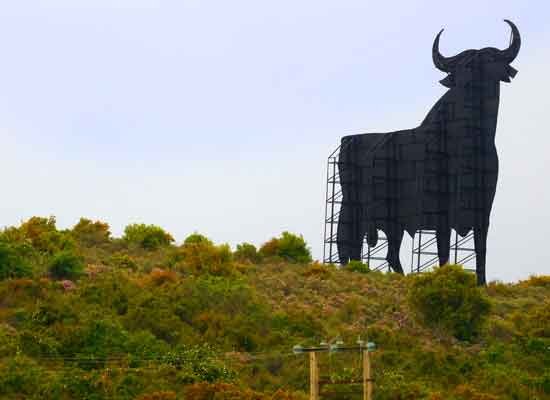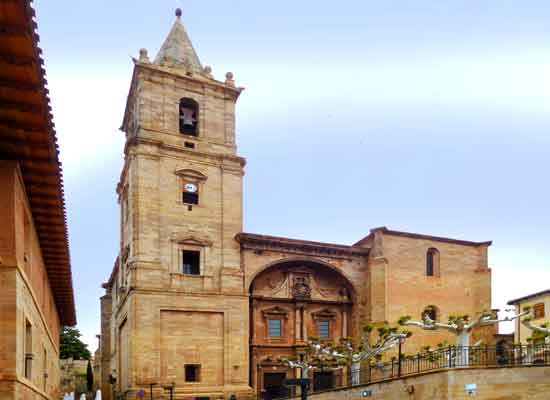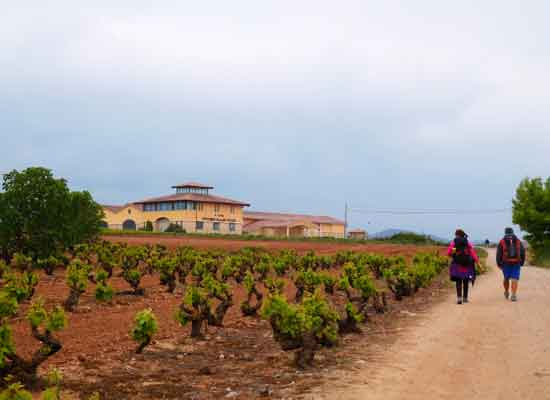Step by Step along The Way of Saint James
From Logroño to Nájera
18 May 2018
Stage 8 – Km. 28

Today's stage covers nearly thirty kilometres.
Despite its length, it doesn’t present significant challenges, although the route involves a steady climb for more than two-thirds of the way. From Logroño, situated at 382 metres, it rises to 668 metres at Alto de San Antón. From there, it’s all downhill to Nájera, with a descent of just under two hundred metres.
Given the distance I need to cover, I set off at 06:30. By now, I’m used to waking up early, and starting at this hour doesn’t bother me at all.
The exit from Logroño is relatively long, but this time, the route is more enjoyable than yesterday’s entry into the city.
I pass through a lovely city park, where I see many people jogging and curious little squirrels watching me.
Shortly after the park, the path runs alongside an artificial lake—the Embalse de la Grajera. It’s one of the few wetlands in the region, a beautiful natural environment with diverse plant and animal species.
The area includes recreational spaces as well as restricted zones to protect the ecosystem.
At the end of the Embalse de la Grajera, I come across a small wooden hut—the Ermita del Peregrino Pasante. Inside, there’s an elderly man with long hair and a bushy beard, dressed like a pilgrim from the past.
His name is Marcelino Lobato Castrillo, a pilgrim who has walked countless routes to Santiago de Compostela—not just the French Way. He’s done it so many times that he’s lost count.
Marcelino is always ready for a chat with those who stop at his hut, offering help and information. Besides providing water and both fresh and dried fruit, he also hands out “bordones” (traditional pilgrims’ walking staffs).
For those who wish, he even has his own personalised stamp to add to the Credencial.
Beyond Logroño, the landscape returns to its rural appearance, now dominated by vineyards stretching endlessly.

Along the route, I spot the massive black silhouette of the Osborne bull on a hilltop. It represents the logo of Osborne, a well-known producer of wines, brandy, and sherry.
Initially conceived as a large advertising billboard, it has since become a cultural symbol of Spain, partly thanks to the famous film Jamón Jamón by Bigas Luna.
Continuing the walk, I see the ruins of the former Pilgrims’ Hospital of San Juan de Acre, built in 1185 to care for travellers.
Next to this site now stands the Don Jacobo winery. A promotional sign on its outer wall, linking the wines to The Way, indicates that Santiago de Compostela is 576 kilometres away. From this, I calculate that I’ve already covered over two hundred kilometres.
This morning, the sky is overcast, and the dark clouds on the horizon don’t look promising. It’s chilly, but the temperature is pleasant and makes walking easier.

At 09:40, I arrive in Navarrete.
In the first bar I come across, I find my Spanish friends, Juaní and Salvador. I join them for a second breakfast—or maybe I should call it “lunch”—since I have a large slice of tortilla with tomatoes, two pieces of bread, and orange juice.
After refuelling with carbs, I explore Navarrete.
In the highest part of the town, I see the Iglesia de Santa María de la Asunción, built in Renaissance style.
Inside, one of its most remarkable features is the imposing Baroque altarpiece at the main altar.
Often, church interiors are dimly lit, but visitors can illuminate them for a few minutes by inserting a €1 coin into a special box.
I make the small investment to better admire the already impressive interior.
Once lit, the gilded altarpiece shines brilliantly, leaving me in awe.
Leaving Navarrete, I walk for more than six kilometres until I reach a fork indicating an alternative route of The Way.
Pilgrims can either continue straight or turn left to pass through Ventosa, a small village known for its artist workshops.
Taking this alternative adds about two kilometres to the stage.
The detour seems a bit contrived—clearly designed to channel pilgrim traffic through the village for commercial reasons.
After considering this, I decide to continue straight, ignoring the alternate path.

Around noon, I reach Alto de San Antón, the highest point of today’s stage. As I pass by, I skirt the Vivanco winery.
From this point onwards, the path descends gently all the way to Nájera.
I finally feel some warmth and can shed my windbreaker and sweatshirt.
The landscape, dotted with vineyards, offers no shade, and the sun starts to feel intense. For the first time on my journey, I feel the need to apply sunscreen.
– Buen Camino! – greet two women walking beside me.
– Igualmente para ustedes. – I reply.
After the greetings, the inevitable question follows:
– De dónde eres? –
– South Africa, – they respond.
– What a wonder! Here are two more people who’ve come from the farthest corners of the world to walk The Way of Saint James. –
A large inscription, painted in block letters on the white wall of a building, informs travellers that “Peregrino: en Nájera, es nájerino.”
The word nájerino is a playful blend of “Nájera” (the name of the upcoming town) and peregrino (pilgrim).
After walking just a few hundred metres more, at 13:30 I finally reach my destination.
Thus ends the seven-kilometre gentle descent from Alto de San Antón to Nájera.
Upon entering the town and crossing the ancient Puente San Juan de Ortega—a bridge with eight arches spanning the Najerilla River—I walk for another twenty minutes to reach the hostel.
The river divides the town into two neighbourhoods: the old quarter to the left and the modern area to the right.
When I arrive at the Albergue de Peregrinos de Nájera, run by the Asociación de Amigos del Camino de Nájera, I find the hostel still closed.
I have to wait about ten minutes until it opens at 14:00.
Alongside me, many other pilgrims—several familiar faces among them—are also waiting outside.
When the doors open, the volunteers managing the facility check us in based on the order of arrival.
The municipal hostel in Nájera consists of one large hall filled with bunk beds.
The sight reminds me somewhat of the scenes, unfortunately often shown on TV, of gymnasiums turned into shelters for earthquake victims after disasters.
Thankfully, the mood here is cheerful, and the bunk beds overflowing with backpacks, sleeping bags, towels, clothes, and laundry hung up to dry create a lively and colourful atmosphere.
– With so many people sleeping in the same room, I bet tonight’s “concert” of snorers will be quite impressive! –
In dormitories like these, snorers are inevitable.
If you’re a light sleeper, you have to be prepared for nighttime “noises” and bring earplugs.
As we get to know each other, no matter how friendly and pleasant someone might be during the day, at night you’ll instinctively avoid sleeping anywhere near them if they’re known to snore.
***
In the afternoon, I go for a stroll with Rocco to explore the town.
Nájera is distinctive for being built beneath a massive outcrop of red rock.
Otherwise, its town centre isn’t particularly striking, except for the Monastery of Santa María la Real, which dates back to the 11th century.
The religious building was constructed at the request of King Don Garcia after the Virgin Mary is said to have appeared to him in a nearby cave.
Unfortunately, the church is closed, and we can’t visit its richly decorated interior.
Among the highlights we miss seeing are a beautiful Baroque altarpiece featuring the Romanesque image of Santa María la Real and the royal pantheon, which houses the tombs of around thirty Navarrese monarchs.
For dinner, we organise an international feast in the hostel.
It’s a long table of Italians, Americans, South Koreans, and Spaniards, with everyone bringing and sharing their own dishes.
We Italians prepare a large mixed salad, along with a delicious pasta and chickpeas dish—which I take charge of cooking.
I find it amusing to share the hostel kitchen with three South Korean girls.
While I cook my pasta, they boil about ten cloves of garlic in the pot next to mine, filling the air with pungent aromas that make my nose twitch.
Although the smell is hard to bear, I jokingly express my discontent to my cooking neighbour. She laughs and fires back with mock disdain for the contents of my pot.
And so, a fun friendship begins with the three South Korean girls, whose names are impossible for me to remember.
Cooking in the hostel is definitely entertaining and a great way to socialise, but otherwise, I find it rather unnecessary.
The cost of groceries, split among us, is roughly the same as the price of a pilgrim’s menu at a restaurant.
Dining out also offers more variety in dishes.
And truth be told, the social aspect exists in restaurants too, where long tables often form with pilgrims from different countries.
Joining us at dinner tonight are Silvia from Venice and Giovanna from Sassari—two young pilgrims who met along The Way and are now walking together.
Silvia plans to end her journey in Burgos in a few days, while Giovanna will soon become a regular companion for me and Rocco.
Giovanna is twenty-six but looks even younger due to her petite frame.
She recently graduated in law and decided to take on The Way of Saint James, an experience completely opposite to her previous way of life.
She recounts how, when she first announced her plans to walk The Way, her mother said:
– You’ll complete the first stage, and once you get to Roncesvalles, you’ll cry and come straight back home. –
Instead, Giovanna has proven herself to be strong-willed and determined.
Despite all the aches and pains she’s endured along the way, she has never given up and has always managed to carry on by herself.
– Will we see her reach Santiago de Compostela? … and afterwards, will she even go as far as Finisterre? –
As the saying goes, we’ll only find out by living—or in this case, by reading the rest of this story.
| © Aldo Lardizzone 2020 |  |
CREATIVE COMMONS |



